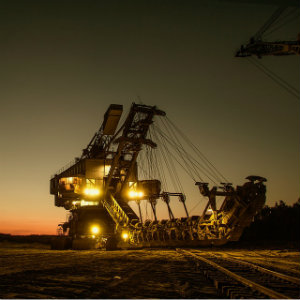Have you or a loved one suffered serious injuries from a construction accident with heavy machinery? You may have several worries:
- How could this accident have been prevented?
- Will I ever fully recover from my injuries?
- What if Workers' Compensation isn't enough?
- Who could be held liable for my expenses?
Our experienced personal injury lawyers are here to help you explore your options.

We're here to represent injured workers and their families. We'll help you earn the compensation you deserve.
Construction work is a dangerous and often thankless job. Construction employees regularly work in hazardous conditions and risk being seriously injured or even killed. Those who work with heavy machinery are often at an even greater risk of serious injury.
The Occupational Safety and Health Administration (OSHA) has identified the "Fatal Four" most common causes of fatal construction accidents. "Struck by object" and "caught-in/between" are at #2 and #4 on the list, respectively. These two categories combined for nearly 17% of construction deaths in 2015. While each category is somewhat broad, both categories contain accidents caused by heavy machinery.
What If Workers' Comp Won't Cut it?
If you've been seriously injured in an accident involving heavy machinery, your workers' compensation insurance will help with medical bills and lost wages. However, sometimes these claims are insufficient for providing relief while recovering from a severe injury. And for the surviving families of fatal construction accident victims, no compensation will ever truly fill the void of a family member's absence.
While you are only allowed to sue an employer in extreme cases, many accidents are caused by the negligence of an on-site third party. So many devastating construction accidents could have easily been avoided if these third parties had acted more responsibly. It's important to hold them liable for the pain and suffering, loss of quality of life, and loss of consortium they've caused.
If you're a construction worker struggling to recover from a serious injury, or a family grieving from a work-related death, a personal injury lawyer can help hold these parties responsible, and help you begin to move on with your life.
FREE CONSULTATION
The Power of Heavy Machinery
These machines are extremely powerful and have the potential to make difficult construction projects much more manageable. However, with such great power comes the potential for serious damage when mistakes are made.
That's why construction sites need to implement rigorous training for the operators of these machines, and consistently evaluate the site for proper safety standards. Examples of heavy machinery include:
- Bulldozers
- Cranes
- Forklifts
- Tractors
- Compactors
- Cherry pickers
- Excavators
- Backhoe loaders
- Pipelayers
- Pavers
- Graders
- Dump trucks & haulers
Proper Safety Standards
Unfortunately, incidents involving these "powered industrial trucks" were the #6 most commonly cited OSHA safety violation in 2016. It's important to hold negligent parties who contribute to heavy machinery accidents responsible for their carelessness. Neglecting proper safety standards with these machines can lead to permanent injuries and fatalities.
Workers deserve to feel safe while on the job. No construction worker should have to worry about permanent disability or death while operating one of these machines. Every construction site that uses heavy machinery should adhere to the following standards:
Guarded Moving Parts
Guards are necessary for many pieces of construction equipment - from hand-held power tools to heavy-duty industrial vehicles. These guards prevent clothing and body part from being caught in the moving parts. Guards also prevent industrial vehicles from being accidentally started.
Machinery Properly Secured
OSHA also suggests that employers "provide a lock-out/tag-out program" to prevent accidental start-ups. These programs require that the machines be rendered inoperative before maintenance work can begin. They also require that "bulldozer and scraper blades, end-loader buckets, dump bodies, and similar equipment must be blocked or fully lowered when being repaired or not in use."
Preventative Measures for Tip-overs
OSHA requires employers to designate a skilled person for inspecting heavy machinery for tip-over hazards. This person is required to identify any hazardous working conditions related to the machinery, and ensure that the machinery is positioned on a surface which can support the heavy weight without the risk of tipping over. These machines must also be equipped with protective structures to prevent tip-overs and rollovers. Furthermore, employees should be required to wear seatbelts while operating heavy machinery.
Preventative Caught-In or -Between Measures
Employers must also regularly implement practices which reduce the risk of a worker being pinned in between heavy machinery and another object, such as a wall or other piece of equipment. This can be accomplished by only allowing necessary personnel into demolition operations, using proper bracing between heavy plates, and by carefully planning travel routes for powered industrial vehicles.
Common Accidents
Each piece of heavy machinery has the potential to inflict a variety of injuries on the operator. Examples of common injuries include:
Limbs and Digits Caught
Sometimes, hands, fingers, and other limbs and digits may get caught in the moving parts of a heavy machine. Workers should check to make sure machine guards are in place to prevent exposure to gears and moving parts.
Runover & Struck-By Accidents
Sometimes, a powered industrial truck may unintentionally start and strike or run over a construction worker. These accidents often result from a lack of safety guards over the vehicle's ignition. In other situations, the vehicle's operator may not have seen the victim because of an obstructed view. In either case, proper safety standards would have likely prevented the accident. OSHA lists "struck by object" as the second leading cause of construction fatalities (at 9.6%), and 75% of struck by accidents involve heavy machinery,
Caught In-Between
As we mentioned earlier, caught in-between accidents rank #4 in construction fatalities. While struck-by accidents refer to incidents where the impact of a single object caused the injury, these injuries are caused when a worker becomes pinned between two or more objects. For example, a worker may suffer serious injuries after a piece of clothing becomes caught in the moving parts of a powered industrial vehicle.
More Info For Injured Workers
Monheit Law Montgomery County Office 215-866-2018
Directions to our Montgomery County Injury Law Office
4V4Q+FM Jenkintown, Pennsylvania
Open 24 hours
Heavy machinery accident attorney Jenkintown
Civil law attorney
Employment attorney
Law firm
Attorney
Social security attorney
Monheit Law South Philly Office 215-302-0095
Directions to our South Philly Injury Law Office
WRCH+CP Philadelphia, Pennsylvania
Open 24 hours
Heavy machinery accident attorney South Philly
Civil law attorney
Employment attorney
Law firm
Attorney
Social security attorney

